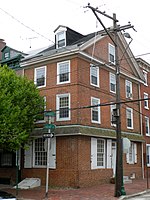Gloria Dei (Old Swedes') Church

Gloria Dei Church, known locally as Old Swedes', is a historic church located in the Southwark neighborhood of Philadelphia, Pennsylvania, at 929 South Water Street, bounded by Christian Street on the north, South Christopher Columbus Boulevard (formerly Delaware Avenue) on the east, and Washington Avenue on the south. It was built between 1698 and 1700, making it the oldest church in Pennsylvania and second oldest Swedish church in the United States after Holy Trinity Church (Old Swedes) in Wilmington, Delaware. The carpenters for the building were John Smart and John Buett and bricks were supplied by Richard Cantril. The church displays the English vernacular style of church design, which combines elements of the Medieval and Gothic styles. The church's vestry and entranceway were added in 1703 to buttress the walls, which had begun to buckle under the weight of the roof. The tower was added c.1733, and interior alterations were made in 1845, designed by Samuel Sloan.The congregation was established on Tinicum Island in 1646. It moved to its present site in 1677, five years before the founding of the city of Philadelphia, and the graveyard around the church to about the same time. Formerly a Swedish Lutheran congregation, the church has been Episcopalian since 1845.
Excerpt from the Wikipedia article Gloria Dei (Old Swedes') Church (License: CC BY-SA 3.0, Authors, Images).Gloria Dei (Old Swedes') Church
South Christopher Columbus Boulevard, Philadelphia South Philadelphia
Geographical coordinates (GPS) Address External links Nearby Places Show on map
Geographical coordinates (GPS)
| Latitude | Longitude |
|---|---|
| N 39.9345 ° | E -75.1435 ° |
Address
Gloria Dei Church (Old Swedes' Church)
South Christopher Columbus Boulevard
19147 Philadelphia, South Philadelphia
Pennsylvania, United States
Open on Google Maps







